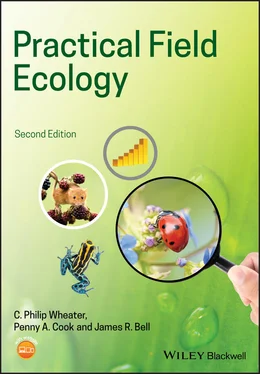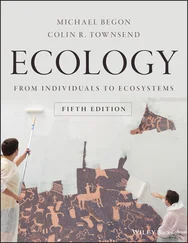1 ...8 9 10 12 13 14 ...22 When planning fieldwork, it is important to take into account your responsibilities and any legal implications of the work. At an early stage in the planning of the project, always seek permission to work on a site from the landowner and any other interested parties (for example, relevant statutory bodies if the sites have some form of special protection, e.g. SSSI or National Nature Reserve). Keep disturbance to a minimum and remove as few plants or animals as possible. Identify specimens in situ (if you can) so that they need not be removed from the habitat. Whole plants should not be taken without the express permission of the landowner. It is good practice in the field not to pick plants of any kind, unless absolutely necessary. In many countries there are a number of protected species (for example orchids) that should not be uprooted, picked, or harmed in any way. You should check with the appropriate governing organisation for the country involved for details on protected species. In some countries there is specific legislation covering protected species (for example, the Endangered Species Act 1971 in the USA, 10 the EU Birds Directive 2009, 11 and the Wildlife and Countryside Act 1981 in the UK 12 ).
Some animals may not be disturbed or handled without a permit (e.g. birds and bats amongst others in the UK), and this extends to some microhabitats (e.g. badger setts in the UK). Rare animals and plants are often protected by law and a licence may be required to handle or disturb them, without which you could face a large fine. You should also consider the ethical aspects of your study. This is particularly important where animals, especially vertebrates, may be harmed. Under these circumstances appropriate licensing authorities should be consulted. Note:this handbook is a guide that does not definitively outline the legal position or interpretation of any act or regulation. In all cases of protected species, it is the responsibility of the researcher to check with the relevant bodies to understand what guidelines and regulations are in force. Legal frameworks can change with time and being unaware of the legality of your actions is not a valid excuse. Therefore, it is important to stay up to date with any legislation pertaining to your area of work.
There are a number of ethical issues that should be considered before engaging on any study, even if there are no legal restrictions on the sampling regime proposed. Where any damage to a habitat or any destructive sampling or organisms is to be attempted, there needs to be a proper evaluation of the balance of costs and benefits. For example, it is possible through handling animals and plants to vector a disease both to animals and humans and thereby increase the risk of spread. Frogs, for example, carry salmonella which can infect humans who come into contact with their faecal matter, but humans can also vector pathogenic fungi to frogs, endangering these amphibians. Large‐scale depletion of populations of plants or animals should not be considered unless the data being generated are of significant value, or the destruction will occur anyway because of another impact (e.g. fogging trees to remove insects where the trees will be clear felled in the very near future – see p. 185). Similarly, where there is a risk of harming non‐target species, the methods should be modified to ensure that these are unaffected. For example, when trapping for small mammals or invertebrates, there is a danger that animals such as shrews can be trapped and killed; modifications to the techniques can avoid this (see p. 266). Such problems can sometimes become apparent only once pilot studies or even the main study has begun. Under such circumstances, the methods should be modified or the study abandoned, particularly in cases where species of conservation importance are under threat. In one such example, whilst pitfall trapping for invertebrates, researchers inadvertently captured a number of great crested newts from wet grassland. Since it would be difficult to exclude the newts from the traps, trapping at this particular site was abandoned (Cullen 1995). When animals are collected alive, they should only be released into the environment from which they were taken to avoid adversely impacting other habitats. Similarly, plant material and soils should not be disposed of in areas where they might cause ecological issues (e.g. biological or heavy metal contamination). Costello et al. (2016) provide a checklist of ethical aspects that should be thought through before, during, and after implementing any field project. Ethical aspects of working on animals are covered by Reed and Jennings (2007). Where relevant, your work may need to be examined through a local ethical review process, often captured in a risk assessment. Most universities and similar organisations operate these, and further details can be found in RSPCA and LASA (2010). It is also worth reading the discussions by Minteer and Collins (2005a, 2005b, and 2008) and Parris et al. (2010) who comment on fieldwork activities.
Look after your own health and safety and that of those around you. All investigations should be assessed for any risks, including those caused by the terrain, the techniques, and any sudden changes in weather (see Barrow 2004). Any chemicals being used should be checked against appropriate regulations and risk assessments should be produced to identify safe use, disposal, and how to deal with spillage and accidents. In the UK, such regulations (COSHH – Control of Substances Hazardous to Health) 13 are covered by the Health and Safety Executive (HSE). Many organisations have their own health and safety guidelines; in the absence of these, advice is available in Nichols (1999), Winser (2004), Aldiss (2007), USHA/UCEA (2011), 14 and Daniels and Lavallee (2014). It is advisable for at least some participants in any field project to be trained in emergency first aid, especially when working in remote environments.
Although all environments are potentially hazardous, you should pay particular attention when working at the coast (especially with regard to tides and hazards including quicksand), rivers (above all with regard to potential flash floods), the uplands and mountain areas (especially with regard to sudden changes in weather conditions and the risk of exposure), and in situations where there is a risk from disease transmission, poisonous and venomous plants and animals, or anti‐social or violent behaviour from other people.
Try to avoid working alone in the field. If you must work alone, always carry a mobile (cell) phone and check out and back in with someone who knows your plan of work. Clothing and footwear should be suitable for the terrain and climatic conditions (warm and waterproof, or cool and sun‐proof). Safety glasses and gloves should be worn to handle chemicals, and suitable gloves to protect you against thorns and infection from soil and waterborne disease. Take particular care where there is risk of disease transmission such as Weil's disease 15 (near to rivers and canals) and Lyme disease 16 (transmitted by ticks). Blooms of some algae, such as Cyanobacteria (blue‐green algae), can be toxic to humans through skin contact and swallowing. 17 In the tropics, it is important to be aware of mosquito‐borne diseases (including but not confined to malaria) and how to avoid being bitten both during the day and at night. 18 Be aware of any other risks, including bites from venomous creatures (e.g. snakes), other toxic species (e.g. poisonous plants, scorpions, spiders, and stonefish, which have toxic spines), and the possibility of rabies from mammals (depending on the country in which you are working). Keep your tetanus injections up to date and consult appropriate authorities (e.g. The UK National Health Service 19 and the US Department of Health and Human Services 20 ) regarding advised vaccines when travelling further afield. In general, ensure you are properly equipped (see Box 1.2) and avoid risks to help to ensure problem‐free project work.
Читать дальше












